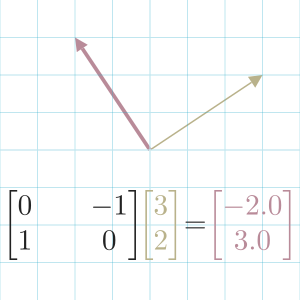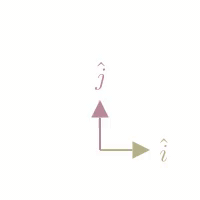Matrix Transformation

We can think of a matrix as a transformation of a Vector or all vectors in space.
When we take the product of a matrix and a vector, we are transforming the vector.
A transformation is another word for a function: it takes in some inputs (a vector) and returns some output (a transformed vector).
For example, we can rotate a vector [xy] some angle θ about the origin using a Rotational Matrix.
[x*y*]=[cosθsinθ−sinθcosθ][xy]
In this example, we perform a 90° rotation of vector [22].

To describe a transformation as a matrix, we only need to record where the Basis Vectors land as columns of a new matrix: [abcd]
For example, a Shear Transformation keeps the ˆi basis vector fixed, and slants the ˆj basis vector. We can record that as: [1102]

A matrix transformation is always linear in that it keeps all gridlines in space are parallel and evenly spaced.
Image processing is a use case for matrix transformations.
Since we represent an image as a m x n grid of pixels, we can treat the position of each pixel as a vector, then perform a transform of each position vector to transform the entire image.
In this example, I rotate an image using the rotational matrix above.
There's some additional code required:
- Create a new matrix that's the maximum possible width and height.
- Convert each position into a vector.
- Convert each position vector, so it's a distance from the center, not top-left.
- Rotate each position.
- Revert convert using a new image size.
image = load_train_image(12)
f, (ax1, ax2, ax3) = plt.subplots(1, 3, figsize=(14, 8))
ax1.imshow(rotate_image(image, 0), cmap='gray_r')
ax2.imshow(rotate_image(image, 90), cmap='gray_r')
ax3.imshow(rotate_image(image, 45), cmap='gray_r')
ax1.title.set_text('0° rotation')
ax2.title.set_text('90° rotation')
ax3.title.set_text('45° rotation')
plt.show()
Note that we end up with some empty pixels in a 45° rotation. These occur because some of the transformed coordinates are floating-point numbers. When they get rounded into integer positions, some of the pixels get excluded. There are many strategies to deal with this, but that's for another article.
References
Gautam Agrawal. Rotating Image By Any Angle Using Only NumPy. September 202. URL: https://gautamnagrawal.medium.com/rotating-image-by-any-angle-shear-transformation-using-only-numpy-d28d16eb5076. ↩
David Dye, Sam Cooper, and Freddie Page. Mathematics for Machine Learning: Linear Algebra - Home. 2018. URL: https://www.coursera.org/learn/linear-algebra-machine-learning/home/welcome. ↩
3Blue1Brown. Linear transformations and matrices. August 2016. URL: https://www.youtube.com/watch?v=k7RM-ot2NWY. ↩